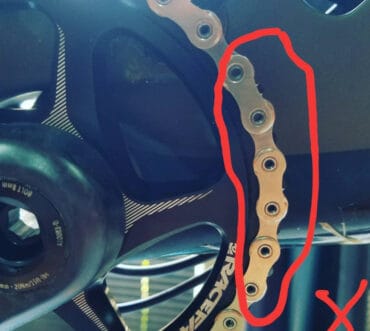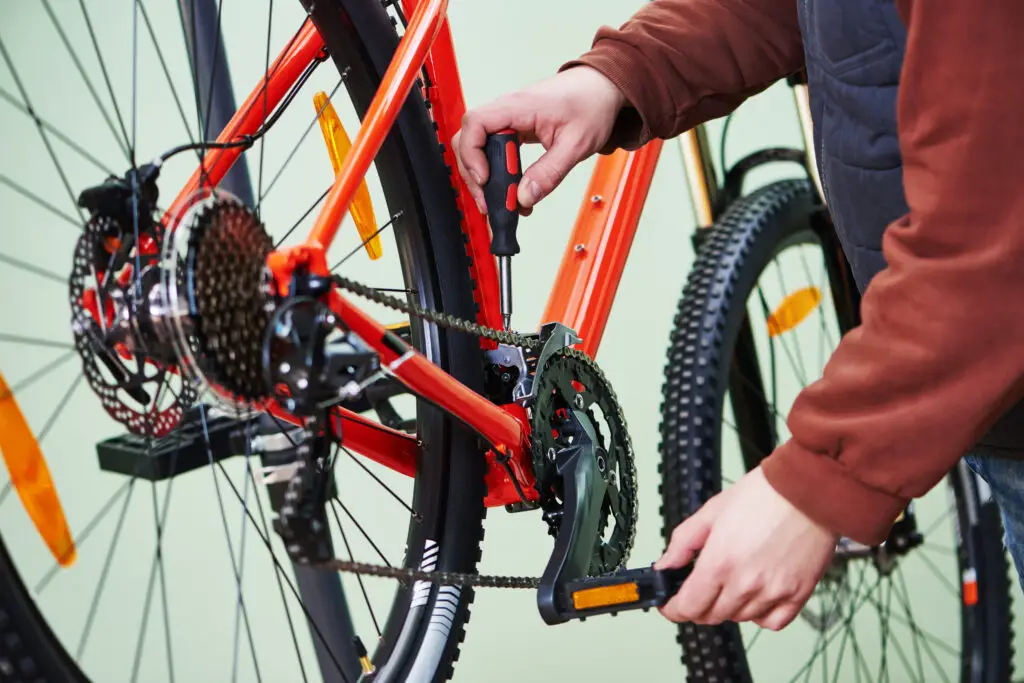
I’ve seen many guides on chains and their installation that don’t ever mention directional chains. This is not one of those guides. We will now address the question: Are mountain bike chains directional?
Only some mountain bike chains are directional. Not every brand chose to make their MTB chains directional because it is not necessary. However, it can benefit weight savings. The best-known brand that has directional chains is Shimano, although not every chain they make is directional.
Why Are Some MTB Chains Directional?
As I understood it over the years, when top brands develop a certain drivetrain, they usually add a new gear feature. To be successful, that drivetrain must keep the same or even improve on its shifting performance. There are many ways to do that with the shape of teeth on a cassette, but shaping the outer plate on a chain helps. Some brands want to keep the chain lighter and therefore put non-symmetrical outer plates where the extra material to shape it is added only on one side.
Does the Chain Direction Matter?
Directional chains feature great shifting performance only in one direction. A directional chain can be ridden in the opposite direction, but it may cause shifting problems. Therefore, chain direction matters only for directional chains, while normal symmetrical chains have the same performance both ways.
Brands That Feature Directional Mountain Bike Chains
In recent years, I didn’t find any new directional chains from top brands except Shimano. Some people say that Shimano likes to complicate things unnecessarily, and I partially agree. However, in this case, I’m not sure. Their drivetrains perform amazingly since 2020. Directional chains might have something to do with that, but I’m not completely sure because I haven’t had the chance to try them out with the KMC chains made to work with the Shimano drivetrain.

Before that, I found KMC chains to be a good benchmark test for certain drivetrains. Mainly to check if they perform well because of teeth shape or the chain.

How to Know If an MTB Chain Is Directional?
Shimano really made it easy to tell the direction of their chains. There is no arrow pointing or something like that. An arrow seems like a perfect pointer, but placing it on one link can make it difficult to find. And if that chain link breaks, after replacing it, you wouldn’t know the direction anymore. Instead, there are markings and letters engraved on one side, and the other is completely blank. The side with the marking must always be visible when the chain is mounted on a bike. That way, you know if the chain is placed in the right direction.
Ensure not to confuse the chain direction with a master/quick link direction, usually indicated with an arrow. Like chains, some master links have direction, and some don’t.
Problems With Installing Directional Chain in the Wrong Direction
On a brand new directional chain, there might be some noise if put in the wrong direction. It happens because of its unsymmetrical outer plates.
However, the bigger problem with installing a directional chain in the wrong direction is the way it impacts shifting performance. It’s the same, like; for example, some SRAM chains having problems shifting on Shimano cassettes and vice-versa.
- The GX Eagle chain is designed with SRAM’s Eagle geometry.
- Features solid pin construction.
- Eagle PowerLock
- Smooth, efficient shifting that you can count on every time o
Prices pulled from the Amazon Product Advertising API on:
Product prices and availability are accurate as of the date/time indicated and are subject to change. Any price and availability information displayed on [relevant Amazon Site(s), as applicable] at the time of purchase will apply to the purchase of this product.
In this case, the other side of the outer plate, which hits the cassette teeth first in the wrong direction, isn’t made to jump onto the next gear. The shape of it gets in the way. It will most certainly shift the gears, but it will be sluggish and might damage the chain under heavy load.

Checking Chain Direction on a New Bike
Checking chain direction on a new bike might seem absurd, but believe me, it’s not. I’ve had countless bikes from the factory with Shimano chains put in the wrong directions at my bike shop. Customers would come with brand new bikes, usually bought online, with questions about why shifting is so poor, only to discover that the chain is put in the wrong direction.
My advice is if your bike is new and shifting isn’t great, this may be the cause. But before you visit a bike shop, check if your chain is directional or not using the guidelines I mentioned above.
Master Link Direction
I’ve mentioned the master link above, and since it’s part of a chain, it’s worth mentioning how it can contribute to the problems with chain direction.
Like chains, only some master links are directional. For example, SRAM eagle chains use directional master links. However, the problems that come with installing them incorrectly are a bit different than with directional chains.
SRAM’s master links are designed to resemble the shape of a chain only on one side. That means if you put it upside down, the chain won’t sit properly on the cassette teeth and might start skipping. Luckily, there is an arrow pointing in the direction of their master links, so it’s not easy to mess it up.
Chain Wear And Chain Direction
There is a trick some people do with semi-worn chains, and that’s flipping them in another direction. It’s supposed to prolong the chain’s life by 20-30 percent. Personally, I don’t believe you gain anything worth mentioning by doing this, but it may be beneficial to point out that directional chains prevent you from doing this. It might be good to keep this in mind if you are replacing your chain anytime soon.
I don’t believe you gain anything because when you understand how the chain works and how it stretches, there is simply nothing much to gain by reversing it. Even if it works, you are just speeding up cassette and crankset wear, bringing higher replacement costs sooner than it would if you replaced the chain instead.

